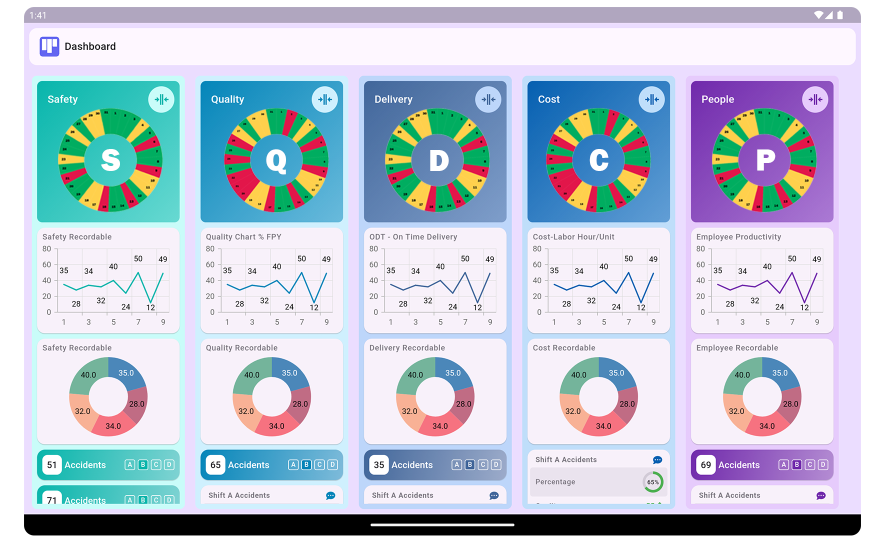A SQCDP board is a powerful visual management tool used to monitor and improve key performance indicators (KPIs) in various projects and processes. The acronym SQCDP stands for Safety, Quality, Cost, Delivery, and People. This board helps teams and organizations track these crucial aspects, ensuring that all elements are aligned with overall business goals. In this guide, we’ll explore how to effectively use a SQCDP board to enhance project management and operational efficiency.

Understanding the Components of SQCDP
- Safety: This component focuses on the health and safety of employees and processes. It emphasizes creating a safe working environment and minimizing risks.
- Quality: This refers to the standard of products or services delivered. Maintaining high quality is essential for customer satisfaction and retention.
- Cost: This aspect involves monitoring expenses related to production or service delivery. Managing costs effectively is crucial for profitability.
- Delivery: This component tracks the timely delivery of products or services to customers. It ensures that deadlines are met, maintaining customer trust.
- People: This focuses on employee engagement, skills development, and overall workforce morale. Engaged and skilled employees contribute to a successful organization.
Step-by-Step Guide to Using a SQCDP Board
Step 1: Set Up the SQCDP board
- Choose a Format: You can create a physical SQCDP board using a whiteboard or corkboard with sticky notes, or you can use digital tools.
- Create Sections: Divide your board into five distinct sections, one for each SQCDP component. Label each section clearly to ensure everyone understands the focus areas.
- Define KPIs: For each component, define specific KPIs that will help you measure performance. For example:
- Safety: Number of incidents reported, safety training completion rates.
- Quality: Defect rates, customer complaints.
- Cost: Budget adherence, cost savings achieved.
- Delivery: On-time delivery percentage, lead time.
- People: Employee turnover rates, training hours completed.
Step 2: Collect Data
- Regular Monitoring: Collect data regularly for each KPI. This can be done weekly, bi-weekly, or monthly, depending on the nature of your projects and the frequency of changes.
- Involve Team Members: Encourage team members to contribute data and insights. This collaborative approach fosters ownership and accountability.
- Use Tools and Software: Utilize project management software, spreadsheets, or reporting tools to track and gather data efficiently. Automating data collection where possible can save time and reduce errors.
Step 3: Update the SQCDP board
- Visual Representation: Regularly update the board with the latest data. Use charts, graphs, or color codes to visually represent performance against targets. This makes it easier for team members to identify trends and areas that need attention.
- Highlight Issues: Clearly mark any KPIs that are below target with red indicators. This draws immediate attention to problems that require action.
- Celebrate Successes: Use green indicators or stickers to highlight KPIs that have met or exceeded targets. Celebrating successes boosts morale and encourages continued effort.
Step 4: Analyze Performance
- Review Data Regularly: Hold regular review meetings to analyze the data presented on the SQCDP board. Discuss what is working, what isn’t, and why.
- Identify Trends: Look for patterns in the data over time. Are safety incidents increasing? Is delivery consistently late? Identifying trends helps in proactive decision-making.
- Root Cause Analysis: For any KPIs that are underperforming, conduct a root cause analysis to understand the underlying issues. This can involve gathering input from team members and stakeholders.
Step 5: Implement Improvements
- Action Plans: Based on the analysis, develop action plans to address any identified issues. Assign responsibilities and set deadlines for implementing these improvements.
- Track Progress: Monitor the implementation of action plans and their impact on the relevant KPIs. Update the SQCDP board with new data as improvements are made.
- Iterate and Adjust: Continuous improvement is key. Regularly revisit your KPIs and action plans, making adjustments as needed to ensure alignment with business goals.
Benefits of Using a SQCDP board
- Holistic View: The SQCDP board provides a comprehensive view of performance across multiple dimensions, enabling teams to see the bigger picture.
- Enhanced Accountability: By clearly defining KPIs and assigning responsibilities, team members are more accountable for their contributions.
- Improved Communication: The visual nature of the SQCDP board promotes better communication within teams, ensuring everyone is on the same page regarding goals and performance.
- Proactive Management: Regular monitoring and analysis allow teams to identify and address issues before they escalate, leading to more effective project management.
- Empowered Teams: Involving team members in the process fosters a sense of ownership and empowerment, leading to higher engagement and motivation.
Conclusion
Using a SQCDP board is an effective way to monitor and improve key performance indicators in any project or organization. By following the steps outlined in this guide, you can set up a SQCDP board that drives continuous improvement and enhances overall performance. Embrace this powerful tool to align your team with strategic goals and achieve better outcomes!